

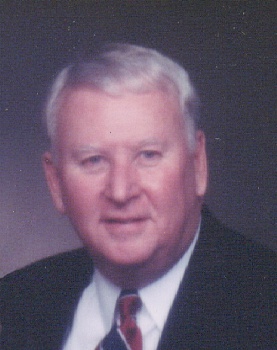



Glenn Eldred Weeks was born in the central San Joaquin valley of California and spent his first years in Jamestown and Sonora, towns in the Sierra Nevada foothills of California, and then in a residence on the Stanislaus River in nearby Angels Camp. When he was six years old, his family moved to the northernmost California County, Siskiyou County, where his father had acquired a 40-acre homesite. Glenn's father, Percy Linton Weeks, was a native of Siskiyou County. Glenn's mother, Martha Helen Weeks, was a descendant of the Jacob Werner family of Stuttgart, Germany. Descendants of this Stuttgart German Lutheran family had migrated to the United States from the Crimea, where they had earlier moved in response to opportunities provided by Catherine the Great of Russia in settling the Ukraine. In the United States they homesteaded and developed farmland in Bowden, North Dakota, before moving to the central California town of Lodi.
In Siskiyou County Glenn's family settled near Scott Bar, on the Scott River, a tributary of the larger Klamath River. (The Scott River and Scott Bar were named after John W. Scott who discovered gold in the river in the summer of 1850.) Scott Bar is not far from the Marble Mountain primitive area of Siskiyou County- the rugged terrain of this mountainous area left Glenn with a lasting regard for the nobility, the sheer beauty and grandeur of the earth and the monumental scale of nature. Glenn attended Scott Bar elementary.
From 1859 to 1870 Glenn's great grandfather, George Morris, served as Deputy Sheriff and Road Overseer of the small town of Happy Camp located on the Klamath River. Mr. Morris (1822-1878/9) was the seventh of eight children born to Joseph Morris (1784-1845) [See endnote #1] and Ann Marchant (1786-1864) of Stone Cross Farm [See endnote #2] in Laughton, East Sussex, England. [See endnote #3]
Mr. Morris should be noted for gathering the people of Happy Camp in a general meeting and introducing the concept of local law--"it is desirable for a community to live by laws," he told them. His proposal of community laws was adopted. He subsequently was elected Sheriff. During his tenure as elected Sheriff of Happy Camp he wrote that he never had a charge escape. And his daughter, Glenn's grandmother, reported that during his tenure he had winning shoot-outs with seven separate outlaws--all seven were reported to be desperate and violent. In these confrontations he was, in his words, "faster on the trigger." (One desperado, an Indian known as 'Bogus Tom,' had killed a man in an altercation at the mouth of Indian Creek.)
After completing high school at Lodi Academy in Lodi, California Glenn spent one year at La Sierra University in southern California (www.lasierra.edu). Glenn subsequently earned a degree in Liberal Arts from Santa Ana College in Santa Ana, California (www.sac.edu). It was during this time that Glenn had exposure and involvement with several competing Christian ideological/eschatological systems (Futurist/Historicist/Independent)-out of these experiences Glenn would synthesize and develop a new Christian worldview which he calls 'Textualism.'
Glenn, in his pre-high school years, had also developed an interest in architecture via the ideas and works of the American architect and apostle of organic design Frank Lloyd Wright (www.franklloydwright.org). Mr. Wright's deep regard for the earth with architecture empathetic to nature as 'man in possession of the Earth.' This struck a cord. With the later introduction to the thinking of the American social philosopher and economist Henry George, Glenn's interests were solidified. Social justice, a regard for nature and the environment, and a viable Biblical worldview were the three-fold transcendentalist avenue to a better world (www.henrygeorgefoundation.org).
Glenn's thesis material presented in his book, GENESIS II, A Radical New Christian Worldview, Volume I, reflects his intellectual heritage and has provided the format for the development and presentation of his unique approach to social and Christian religious issues. Glenn started his business career in San Francisco where he worked as a sales representative for a computer services company headquartered in Minnesota. After several years' work as a successful sales representative, he was sent to Boston to open the company's branch office. Subsequently Glenn was transferred to their office in New York City. The transfer was fortuitous as Glenn's stay in New York City proved to be a life changing catalyst that crystalized his background interests into a life work that went beyond his beginning business experiences.
During his stay in New York City, Glenn enrolled and attended Columbia University (www.columbia.edu) where degree work was pursued in Economics and Philosophy. Glenn currently holds degrees in Liberal Arts and in Economics with depth requirements completed for a degree in Philosophy. In New York, Glenn also associated with and held membership in Park Avenue United Methodist Church located on East 86th Street: The Methodist denomination is a non-creedal church organization which Glenn found compatible with his belief structure. In his personal life Glenn is an existentialist-that is, living precedes essence; life consists not from where you start-it is what you become. As maturity transcends youth, the later state is personal life essence and this state is continuously progressive.
It was also in New York where Glenn became an aficionado of modern art (impressionism and cubism to post-modern and contemporary/abstract art) with its reductionist but symbolic representational content-the art of Joan Miro, Fernand Léger, Amedeo Modigliani, Constantin Brancusi, Ellsworth Kelly, and others.
 Earlier he had been introduced to modern art via a class in 'Creative Thinking' taken from the legendary (Paul Baker) at Baylor University. However, it was in New York that he became intrigued with the mobiles of (Alexander Calder) and his work with primary colors--and he became an enthusiast of modern sculpture. He subsequently commissioned a personal sculptural creation by New York sculpturer Anthony Padovano. (Anthony Padavano Sculptor)
Earlier he had been introduced to modern art via a class in 'Creative Thinking' taken from the legendary (Paul Baker) at Baylor University. However, it was in New York that he became intrigued with the mobiles of (Alexander Calder) and his work with primary colors--and he became an enthusiast of modern sculpture. He subsequently commissioned a personal sculptural creation by New York sculpturer Anthony Padovano. (Anthony Padavano Sculptor)
Economic social justice has long been of personal interest to Glenn. While in San Francisco, he became involved in a study of the social philosophy of the famous San Francisco philosopher and economist Henry George. He found the Georgist analysis so compelling he became an instructor at the San Francisco Henry George School and served on the school's Board of Trustees. After Glenn was transferred to New York City, he was invited to serve as a Board of Trustees member for the US headquarters Henry George School of Social Science then located on 68th Street near Hunter College in New York.
While serving on the Henry George School Board of Trustees, Glenn was involved with a school-funded advocacy program promoting a change in the incidence of property taxation rates in Pittsburgh, Pennsylvania. This was in response to an inquiry/request by Dr. Steven Cord, school associate and activist. (Subsequent presentations by Dr. Cord and Dr. Philip Finkelstein, director of the school's program of economic research, were successful and resulted in the incidence of taxation rates being raised for the land component and lowered on improvements with a salutary statistically validated effect on municipal growth as the tax policy encouraged increased employment.) This program was a demonstration of the viability of Georgist economic policies--the changes were otherwise revenue-neutral to total tax collections. This effort was reported in Fortune magazine (Higher Taxes That Promote Development), Fortune, August 3, 1983.) Subsequently, the method of property taxation initiated in Pittsburgh was implemented in eighteen other Pennsylvania municipalities and taxing jurisdictions with positive results. [See endnote #4)
Glenn's continued involvement with Site Value Taxation policies motivated him to pursue professional competency in real estate appraisal and specialize in residential land value issues. For years Glenn held a Certified Residential Appraiser license (AZ22164) in Arizona.
In addition to social justice concerns Glenn has long had an interest in Christian thought--particularly in eschatological issues, which characterize different Christian denominations. Glenn's synthesis of elements in this field constitutes a new interpretation of source materials, a root treatment of textual issues, and results in a radical new Christian worldview and new Christian interpretation of history. In addition, the extensive involvement and pronouncements of Jesus regarding land ethics that was developed in the course of his research was so pertinent and unique that Glenn felt it should be shared--and in the 1970s work was begun preparing the material for distribution. The categorization of privatized land values as the critical element contributing to world poverty singularly distinguishes this work.
As noted, Glenn's long interest in Christian thought and economics have motivated him to write a book. The book is entitled GENESIS II, A Radical New Christian Worldview. (Barbara named the book and did much development work on the manuscript.) The book highlights economic theory with a presentation of an alternative to monopoly capitalism and socialism—essentially the policies of Henry George presented in his great book Progress & Poverty. The book also shows that the Biblical concepts of a just society, if implemented, would solve the problem of world-wide poverty. Glenn's book, GENESIS II A Radical New Christian Worldview, Volume I, has been published as a 6' x9' 386 page paperback. The book, now also in hardcover and E-book versions, is currently available on a number of sources including Amazon Books.
In addition to Volume I, a second book in the envisioned three book GENESIS II series is currently in development. Volume II is entitled GENESIS II The Singular Sign of Divine Authority. Volume II shows that the traditional time allotment of three hours for the fifty-one-step trial of Jesus cannot be substantiated. The fifty-one-step trial time, analyzed by computerized transaction timing analysis, shows the trial spanned much more time than the three hours assumed by tradition is required—in fact an entire day. The identified missing trial day is Thursday. It is projected as ending at midnight, at the 6th hour, as the Gospel in John indicates (John 19:14). (Note: There are two 6th hours in a full day per Jewish timekeeping, one at midnight and the other at noon). On the crucifixion day, Friday, Jesus was on the cross at noon, the 6th hour of the day, having been crucified at 9:00 am and dying at 3:00 pm. The other 6th hour of the crucifixion day is midnight. This is when Pilate condemned Jesus to death after a full day trial, Thursday. The corrected time of the trial spanned a full three days and three nights—72 hours, as shown in the illustration below:
Three Days & Three Nights—The Trial & Crucifixion of Jesus

This timing analysis requires that the trial timing be corrected to reflect the analysis. Jesus said the trial sign was three days and three nights (Matthew 12:39-40).
 Glenn was married to Barbara (née Sodeman). Glenn and Barbara were married February 3, 1976. They had one daughter, Kimberly. Glenn and Barbara met in Boston where Barbara worked as a secretary to the academic dean at Eastern Nazarene College. They first lived in New York City before moving to California and then to Phoenix, AZ.
Glenn was married to Barbara (née Sodeman). Glenn and Barbara were married February 3, 1976. They had one daughter, Kimberly. Glenn and Barbara met in Boston where Barbara worked as a secretary to the academic dean at Eastern Nazarene College. They first lived in New York City before moving to California and then to Phoenix, AZ.
It is with incredible sadness and regret that I must report that my wonderful wife and companion of 40 years succumbed suddenly (January 5, 2017) to an abdominal infection caused by a physician prescribed Antibiotic. Neither of us saw this coming.
The framed plaque shown below has a little story behind it and I add it as a memory of Barbara.
This past Christmas 2016 with standard gift giving I asked Barbara if there was anything else she might like for Christmas: "Yes," she said, "I have my life motto on a plaque and I'd like it framed." So I took the plaque to a frame shop and had it framed and it was added to the Christmas gifts. I was able to get the plaque hung in her office and it was there 7 or 8 days before she left us. In this regard she told me that her favorite Hymn was "His Eye Is on the Sparrow" which was sung at her memorial service during the screen display of the plaque below.

In Arizona Barbara taught business courses at an on-line high school. For five seasons Barbara also sang in the Phoenix Symphony Chorus (www.phoenixsymphony.org) under the direction of Michael Christie, the Phoenix, AZ Symphony maestro. She considered singing in the Phoenix Symphony Chorus as one of her most rewarding achievements.
 After they were married in 1976, Glenn and Barbara lived at 1725 York Avenue in the Yorkville district on New York City's upper east side. They occupied a 30th floor unit with a panoramic view of parts of New York City. They both found high-rise living to be a wonderful experience, and they missed the New York City lifestyle. Glenn lived at this York Avenue residence address for eight years before the transfer to California, four of those years after he and Barbara were married.
After they were married in 1976, Glenn and Barbara lived at 1725 York Avenue in the Yorkville district on New York City's upper east side. They occupied a 30th floor unit with a panoramic view of parts of New York City. They both found high-rise living to be a wonderful experience, and they missed the New York City lifestyle. Glenn lived at this York Avenue residence address for eight years before the transfer to California, four of those years after he and Barbara were married.
In 1980 Glenn was transferred to San Francisco by the Boeing Company. Glenn first served in a San Francisco sales capacity for Boeing Computer Services' (BCS) scientific computing (Nuclear and Structural codes) via Boeing's Cray computer in Bellevue, Washington. Later Glenn was employed by Tandem Computers, a computer hardware manufacturer headquartered in Silicon Valley. Glenn became a member of the large account sales team with Tandem (Tandem manufactured fault-tolerant non-stop processors) and represented their 'Paperless Factory' system implementations and their non-stop ATM banking systems.



 In the early 1990s Glenn moved his family from California to Phoenix, Arizona, to accept an available employment opportunity. In Phoenix Glenn currently serves as president/CEO of AMS, Inc., an Arizona 'C' corporation that he founded.
In the early 1990s Glenn moved his family from California to Phoenix, Arizona, to accept an available employment opportunity. In Phoenix Glenn currently serves as president/CEO of AMS, Inc., an Arizona 'C' corporation that he founded.
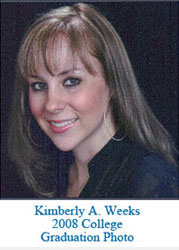
In 2008 Glenn and Barbara's daughter Kimberly graduated cum laude with a degree in English from Pacific Union College in Angwin, CA. Kimberly recently was awarded her Master's Degree in Psychology from Arizona State University. Kimberly currently works as a Marketing Manager for a publishing company in California.
On Sunday, November 5, 2017, Kimberly married Coltere Lockhart in a ceremony in Sedona, Arizona. The marriage was held outdoors beside a running stream with Cathedral Rock in the background. This was the setting that Kimberly had always dreamed about. They currently reside in Apple Valley, California where Coltere accepted an employment opportunity.
1. Joseph Morris, of Laughton, East Sussex was, after leaving farming, a shopkeeper at 27 High Street, Lewes. (Lewes is located some 24 miles west of Hastings were the Battle of Hastings was fought and about 12 miles south of Laughton.) Mr. Morris was a religious man, a trait that had characterized his deeply religious father. Mr. Morris's father, also named Joseph Morris (1752-1826), was one of the first trustees of Jireh Chapel on Malling Street in Lewes and a close friend of William Huntington. William Huntington, an iconoclastic Calvinist preacher of the area, became associated with Jireh Chapel in 1805 (Jireh Chapel had been founded by Jenkin Jenkins). Glenn's great grandfather George Morris was baptized in this chapel in 1824, at two years of age.
Notes on Jireh Chapel:
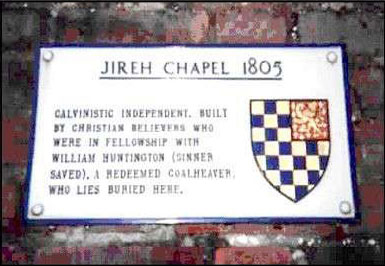
Calvinistic Independency can be traced back to Puritan times in England. Despite the subsequent doctrinal decline that led many into formalism and others into serious errors, Free Grace religion was preserved in many parts of the country. In many Independent and Particular Baptist churches, Calvinistic truth was adhered to and faithfully advanced. Some weight was added to this testimony by those associating themselves with the position taken by George Whitefield in the Evangelical Revival of the 18th Century. In the providence of God, the county of Sussex was greatly influenced by the preaching of those doctrines of electing love and sovereign grace. The East of the county was particularly strong in its Calvinism. It cannot be doubted that those who commenced the new work had become followers of one of the most remarkable men of the period, William Huntington SS. That William Huntington lived by the doctrines of grace is at once clear to any who read his writings. Saved by the sovereign grace of God. Greatly gifted as a preacher, he excelled in controversy. But it was not merely as a controversialist that he built up a following. His ability to preach Calvinism to the heart of a man made him one of the greatest exponents of experimental Calvinism of his day or any since." (Excerpted from an article written by K F T Matrunola MA BD, Pastor of Salem Strict Baptist Chapel, Portsmouth.)
Lewes is also famous as the home of Thomas Paine, humanist-theorist of the American Revolution. A plaque at White Hart Hotel on High Street commemorates the hotel as a place where Thomas Paine first developed and presented his ideas. A few doors west of the White Hart Hotel is the meeting place of the 'Dissenters' of 1662, first known as Presbyterians; they were later to become the Unitarians. After leaving farming, Joseph Morris became the owner and proprietor of a store located at 27 High Street, several doors east of the White Hart Hotel.
In addition, Lewes is the country retreat of the Bloomsbury Group. The Bloomsbury Group first came to the area in 1916. Vanessa Bell and Duncan Grant and their unconventional household developed Charleston Farmhouse-7 miles east of Lewes. Inspired by Italian fresco painting and the Post-Impressionists they painted the walls, doors, furniture and ceramics in their own personal style and transformed the house and decorations. The Bloomsbury Group included such personages as Clive Bell, David Garnett and the noted economist John Maynard Keynes. Nearby Monks House was home to Virginia Woolf, also of the Bloomsbury Group.
2. During the early 1800's the Joseph Morris family owned Stone Cross Farm in Laughton, East Sussex, England. (This was the 3rd Joseph Morris in the family line: 1st Joseph Morris-1717-1795, 2nd Joseph Morris-1752-1826, 3rd Joseph Morris-1784-1845.) Stone Cross Farm was a 50-acre farm just to the east of Laughton town center. The main house and surrounding buildings still exist. (The main house is shown in the photograph below. [Roof color altered]. Also shown is All Saints Church in Laughton.)
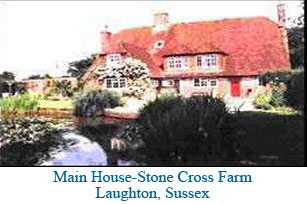
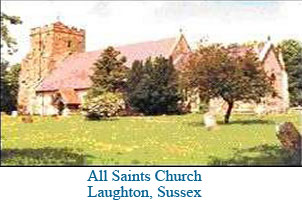
All Saints Church was the parish church of the Morris family while living in Laughton. All Saints' Church Laughton-en-le-Morthen was built in 1229 A.D. by the Saxons and later, in the 1300's, was renovated by the Normans. All Saints is considered to be one of the one thousand best-preserved churches of England. (When the author and his family visited Laughton they attended a regular worship service being conducted in this historic church.) Later the Morris's were parish members of All Saints' Church on Landsdown Place in Lewes. Glenn's great great-grandparents, Joseph and Ann Morris, are interred in a large family vault located at the southwest corner of All Saints' churchyard in Lewes.
3. Morris family researchers have meticulously documented their ancestry thirty-two generations, from the Morris family line through the family of Shoosmiths, through the family of Peverels, and maintain that evidence substantiates that the family descended from William Peverel (Born in Normandy about 1046/1051 - Died.April 17, 1113 in England), an alleged illegitimate son of Maud Peverel and William I (b 1027 - d 1087), the Conqueror, of nearby Battle of Hastings fame (Saturday, October 14, 1066). Notwithstanding the work of Morris family researchers, the author has been unable to confirm, from corroborating sources, the alleged family connection with the Conqueror (Duke of Normandy).† Research genealogical notes indicate the reference was provided by Daphne Scott, per Clifford-Wilson, Rome, and includes the following disclaimer: "The descent from the Conqueror is from Turton's 'The Plantagenet Ancestry,' and, as such, cannot be entirely relied upon. The DNB articles on the Peverels mention it as being from Dugdale only, and thus unreliable. He (William I) did not marry Maud Peverel." Note: Maud Peverel was a Saxon [b 1032 at St. Martins Le Grand, London, England], the daughter of Ingelric--it has been reported that Maude was a celebrated beauty in her time and that she was wealthy.
† The heritage of William I, Duke of Normandy, has been traced to Rollo (b. 860 AD - d. 932 AD), an earlier Duke or Count of Normandy. In 885 Rollo had besieged Paris under Sigfred and later invaded the area of northern France now known as Normandy--named such because the region they occupied was held by Rollo's Norsemen ('Norsemen' derived from the identifying designation northman'). Rollo was a Viking leader of either Norwegian or Danish origin. Today, scholars disagree on the question of Rollo's Scandinavian origins.
In a church wedding in1060, when she was 28, Maud married Ranulph Peverel from whom William took his name--however, rumors continue to persist that William [Called 'the Elder'] was the illegitimate son of William I, the Conqueror, and Maud Peverel.
It is recorded (The Battle Abbey Roll) that William Peverel fought at the Battle of Hastings--he would have been young, from 15-20 years of age. After the Norman conquest, related or not, the Conqueror, William I, having been crowned England's king in Westminster Abbey on Christmas Day of 1066, greatly honored the young William Peverel to whom he assigned over 150 holdings in central Britain. (In 1086, the Domesday Book* records William Peverel as holding 162 lordships, called the Honor of Peverel, in Derbyshire and Nottinghamshire.) One of the property assignments was Nottingham Castle, which the Conqueror had constructed for the young William Peverel. Although the Conqueror had promised 'spoils' to his soldiers the question arises: Why would he assign these extensive holdings and build this elaborate structure for one of his young soldiers if there were not a personal relationship that motivated special consideration? Does not this substantial largesse suggest that William Peverel and the Conqueror had an unusually close relationship (probable father & son)? Nottingham Castle, as it exists today, is illustrated on the following page.
* The Domesday Book, a detailed survey and record of land holdings in England, was begun in 1086 and detailed 13,418 holdings. The Domesday Book was the precurser of modern assessment rolls.
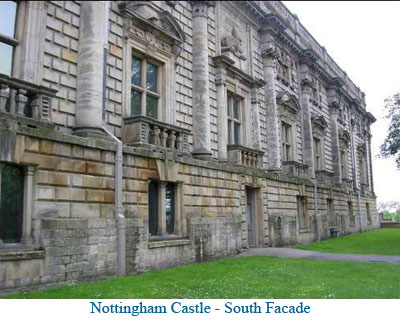
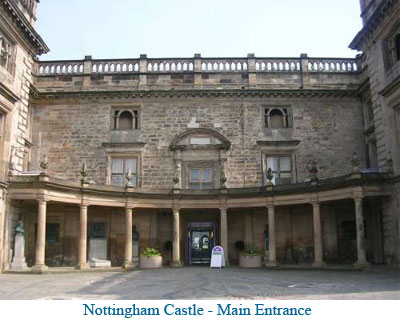
William I, The Conqueror, had Nottingham Castle constructed for William Peveral in 1067-8. It was a wood building built on the brow of a 130 foot high sandstone cliff located directly west and to the south of the castle. The present 'Ducal Mansion' was built by the 2nd Duke of Newcastle, Henry Cavendish, between 1674 and 1679 on the foundations of the original structure. The rebuild was inspired by Italian architecture.
(Note: In the legends of Robin Hood, Nottingham Castle is the scene of the final showdown between the Sheriff and the hero outlaw. And the castle has been the site of many other notable occurrences.)
4. Shifts in the incidence of property taxation which placed more taxing weight on land and relatively less on improvements were implemented in the following Pennsylvania municipal taxing jurisdictions: Alliquippa City, Alliquippa School District, Allentown, Clairton, Coatesville, Connellsville, Dubois, Duquesne, Ebensburg, Harrisburg, Lock Haven, McKeesport, New Castle, Oil City, Pittsburgh, Pittsburgh Improvement District, Scranton, Steelton, Titusville, and Washington. Further information and statistical data on implementations may be obtained from the following: Center for the Study of Economics, Central Business District, 1501 Cherry Street, Philadelphia, PA 19102 (267) 519-5312 NE Branch Office, 7488 Oxford Avenue, Philadelphia, PA 19111 [www.urbantoolsconsult.org]**/***
Glenn E. Weeks
glenneweeks@gmail.com
**Mark Speirs, Land Value Taxation: An Underutilized Complement to Smart Growth Polices (A Project Submitted to The Chair, Department of Community and Regional Planning, In Partial Fulfillment of the Requirements for Degree MASTER OF SCIENCE, Community and Regional Planning, Temple University, Philadelphia, Pennsylvania, December 13, 2010) This project analysis (Click here to read more ) is an excellent review of implementation concepts, benefits, and issues associated with Land Value Taxation.
***Ted Gwartney, MAI, Assessor, Greenwich, Conneticut, Estimating Land Value. A primer on assessing and
and taxing land values. [ Click here to read more ]